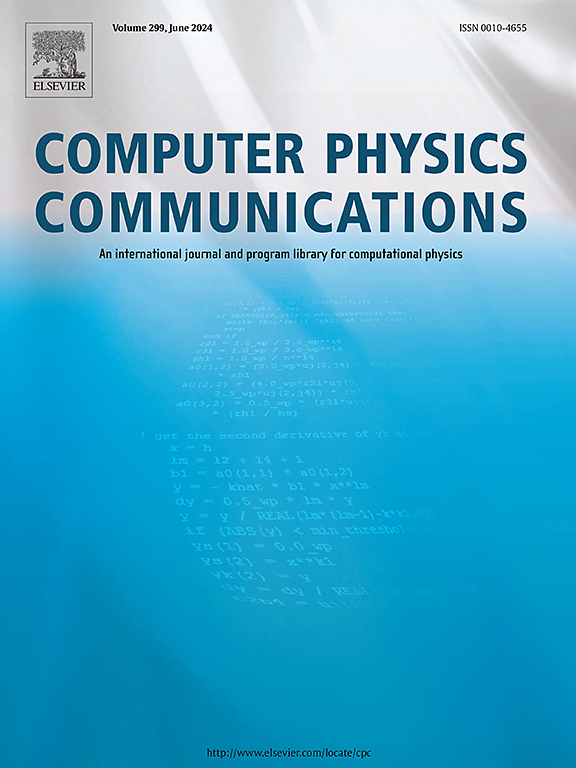Fractal-constrained deep learning for super-resolution of turbulence with zero or few label data
IF 7.2
2区 物理与天体物理
Q1 COMPUTER SCIENCE, INTERDISCIPLINARY APPLICATIONS
引用次数: 0
Abstract
The super-resolution of turbulence is of paramount importance and still remains challenging due to the inefficiency of the current technologies in retaining the intrinsic physics like the multi-scale flow structures and energy cascades. To address this challenge, this work proposes a fractal-constrained deep learning super-resolution model termed SKFSR-FIC. The model is characterized by two distinctive designs: (1) a SKip-connected Feature-reuse Super-Resolution (SKFSR) network that learns and retains multi-scale flow structures and multi-frequency dynamics, achieving efficient upscaling of flow fields while reconstructing self-similar physics; (2) a fractal invariance constraint (FIC) that utilizes the self-similarities of flow properties invariant to scales to substitute label data information in super resolution, thus achieving accurate reconstruction of multi-scale dynamics and energy cascades. The SKFSR-FIC model, for the first time, leverages fractal dimensions to guide the turbulent flow reconstruction and significantly reduces the reliance on label data and, especially, achieves zero-shot (i.e., unsupervised) super-resolution that cannot be handled by existing deep learning models. The results from five self-affine fractal images and two turbulent flow cases demonstrate the enhanced efficiency (up to 2 times) and accuracy (up to 100 times) of the unsupervised SKFSR-FIC model compared to the conventional interpolation method and deep learning models. Moreover, the SKFSR network is compatible with both FIC and label data, thereby adaptively enabling unsupervised, supervised and semi-supervised learning strategies. In particular, the semi-supervised SKFSR-FIC model, even by using one snapshot, achieves the best accuracy among the three learning strategies due to the combination of physics and data.
基于分形约束的湍流超分辨率深度学习
湍流的超分辨率是至关重要的,但由于目前的技术在保留多尺度流动结构和能量级联等内在物理特性方面效率低下,因此超分辨率仍然具有挑战性。为了解决这一挑战,本研究提出了一个分形约束的深度学习超分辨率模型,称为SKFSR-FIC。该模型具有两个独特的设计特点:(1)基于skip连接的特征重用超分辨率(SKFSR)网络,该网络学习并保留了多尺度流结构和多频率动力学,在重建自相似物理的同时实现了流场的有效上尺度;(2)分形不变性约束(FIC),利用流动特性与尺度不变的自相似性来代替超分辨率的标签数据信息,从而实现多尺度动力学和能量级联的精确重建。SKFSR-FIC模型首次利用分形维数来指导湍流重建,显著降低了对标签数据的依赖,特别是实现了现有深度学习模型无法处理的零射击(即无监督)超分辨率。5张自仿射分形图像和2个湍流实例的结果表明,与传统插值方法和深度学习模型相比,无监督SKFSR-FIC模型的效率提高了2倍,精度提高了100倍。此外,SKFSR网络兼容FIC和标签数据,从而自适应地实现无监督、有监督和半监督学习策略。特别是半监督的SKFSR-FIC模型,即使使用一个快照,由于物理和数据的结合,在三种学习策略中获得了最好的准确性。
本文章由计算机程序翻译,如有差异,请以英文原文为准。
求助全文
约1分钟内获得全文
求助全文
来源期刊

Computer Physics Communications
物理-计算机:跨学科应用
CiteScore
12.10
自引率
3.20%
发文量
287
审稿时长
5.3 months
期刊介绍:
The focus of CPC is on contemporary computational methods and techniques and their implementation, the effectiveness of which will normally be evidenced by the author(s) within the context of a substantive problem in physics. Within this setting CPC publishes two types of paper.
Computer Programs in Physics (CPiP)
These papers describe significant computer programs to be archived in the CPC Program Library which is held in the Mendeley Data repository. The submitted software must be covered by an approved open source licence. Papers and associated computer programs that address a problem of contemporary interest in physics that cannot be solved by current software are particularly encouraged.
Computational Physics Papers (CP)
These are research papers in, but are not limited to, the following themes across computational physics and related disciplines.
mathematical and numerical methods and algorithms;
computational models including those associated with the design, control and analysis of experiments; and
algebraic computation.
Each will normally include software implementation and performance details. The software implementation should, ideally, be available via GitHub, Zenodo or an institutional repository.In addition, research papers on the impact of advanced computer architecture and special purpose computers on computing in the physical sciences and software topics related to, and of importance in, the physical sciences may be considered.
 求助内容:
求助内容: 应助结果提醒方式:
应助结果提醒方式:


